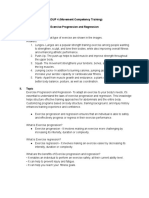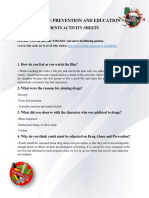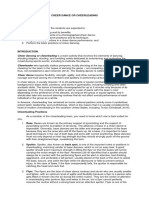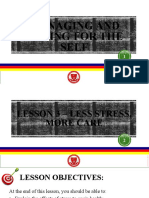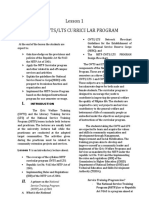NSTP Module 5
NSTP Module 5
Uploaded by
Shiedrick Conde BacolodCopyright:
Available Formats
NSTP Module 5
NSTP Module 5
Uploaded by
Shiedrick Conde BacolodCopyright
Available Formats
Share this document
Did you find this document useful?
Is this content inappropriate?
Copyright:
Available Formats
NSTP Module 5
NSTP Module 5
Uploaded by
Shiedrick Conde BacolodCopyright:
Available Formats
Shiedrick C.
Bacolod
Practice
_________________________________________________________________
Picture Not Mine. Credits to the owner.
NSTP-CWTS Take-Away – 08
DRRM Awareness
Name: Shiedrick C. Bacolod Date Given: 12/11/2021
Prog. /Yr./Sec.: BSIT 1-A Score: _______
Due Date: 12/18/2021
Activity:
Watch the video clip entitled “Prepared Communities are safer communities”
via https://youtu.be/V9jMOi5Byhc?list=PL8CD23028A59D4074 . After watching
the video, answer the questions below:
1. Why is there a need to have comprehensive planning for disaster risk
management?
Comprehensive planning is crucial for a community since it focuses on
ensuring the safety of people and property while also promoting community
investments. Our community will be able to withstand any calamities or
disasters as a result of this. Furthermore, comprehensive coordination is vital
for a community to effectively prepare for, respond to, and recover from any
hazardous events. In fact, it really provides a method for dealing with complex
challenges our community has experiencing in a manageable manner.
2. Discuss the four thematic areas of DRRM.
The DRRM covers four thematic areas, namely, (1) Prevention and
Mitigation; (2) Preparedness; (3) Response; and (4) Rehabilitation and
Recovery.
First and foremost, the Prevention and Mitigation refers to the complete
avoidance, reduction, or limiting of the detrimental effects of risks and related
catastrophes. The next category is Preparedness, which refers to the
knowledge and expertise that governments, professional response and
recovery organizations, communities, and individuals have developed to
effectively anticipate, respond to, and recover from the effects of likely,
imminent, or current hazard events or conditions. The third is Response,
which involves providing emergency services and public aid during or
immediately after a disaster in order to save lives, limit health consequences,
guarantee public safety, and satisfy the basic subsistence requirements of
those harmed. And lastly, the Rehabilitation and Recovery, pertains to actions
that assure impacted areas' ability to return to normal levels of functioning
through restoring livelihoods and destroyed infrastructures, as well as
strengthening community organizational capacity.
Shiedrick C. Bacolod
Each thematic area has its own goal which is listed below:
Prevention and Mitigation
Reduce vulnerabilities and exposure, as well as enhancing community
capacity, in order to avoid hazards and mitigate their potential impacts.
Preparedness
Establish and strengthen capacities of communities to anticipate, cope
and recover from the negative impacts of emergency occurrences and
disasters.
Response
Provide life preservation and meet the basic subsistence needs of affected
population based on acceptable standards during or immediately after a
disaster.
Rehabilitation and Recovery
Restore and improve facilities, livelihood and living conditions and
organizational capacities of affected communities, and reduced disaster risks
in accordance with the “building back better” principle.
All of these goals are supporting the attainment of the country's overall goal;
“Safer, adaptive and disaster resilient Filipino communities toward sustainable
development.”
3. What is your insight about the video clip?
As I watched the video clip, I was enlightened about the community
preparedness. It is evident that being prepared is crucial to a community's
ability to respond to and recover from catastrophic events, and this will
become possible through engaging and coordinating with a wide range of
state, municipal, tribal, and other stakeholders. It was shown in the video that
the Red Cross and Red Crescent Societies around the globe has always
been helping with vulnerable communities to prepare for, respond to, and
recover from calamities. They are always in the forefront of disseminating
beneficial Disaster Risk Reduction and Management (DRRM) information.
They also established programs to successfully prepare locals and residents
in general with the necessary skills to be resilient and effectively deal with the
destructive impacts of a disaster. Therefore, I came to the realization that
Disaster Risk Reduction and Management (DRRM) is indeed vital for a
community to be prepared, because preparedness simply means safety.
Shiedrick C. Bacolod
Perform
_____________________________________________________
Picture Not Mine. Credits to the owner.
NSTP-CWTS Social Action Activity No. 05
My Barangay’s LDRRM
Name: Shiedrick C. Bacolod Date Given: 12/11/2021
Prog. /Yr./Sec.: BSIT 1-A Score: _______
Due Date: 12/18/2021
Activity:
Explore the Disaster Risk Reduction and Management Plan of your barangay
and know the committee and their functions…
Note: Attach a copy of the Local Disaster Risk Reduction and Management Plan of your
barangay.
1. This is the composition of LDRRM officers of my barangay:
2. What are their functions?
Shiedrick C. Bacolod
3. What is the significance of having Disaster Risk Reduction and Management Plan in
your barangay?
You might also like
- Exercise Progression and RegressionDocument3 pagesExercise Progression and RegressionKian Macaraeg100% (1)
- All About Pasalubong Center 2 D R A F TDocument14 pagesAll About Pasalubong Center 2 D R A F TEGUIA, MARY SHENIETH M.100% (4)
- Module 2 Unified Course Pack CWTS 1 2021 2022Document13 pagesModule 2 Unified Course Pack CWTS 1 2021 2022Jelaine Bacatan CuestaNo ratings yet
- Module # - Part - Basic First Aid Training: I. ObjectivesDocument10 pagesModule # - Part - Basic First Aid Training: I. ObjectivesMendoza Mhadz100% (3)
- Physical Self Image MatterDocument72 pagesPhysical Self Image MatterMark225user100% (2)
- The E Myth WorkBook2Document23 pagesThe E Myth WorkBook2Marty Kind93% (15)
- People Express Airlines: Rise and DeclineDocument9 pagesPeople Express Airlines: Rise and Declinepreeti jhaNo ratings yet
- Drug Abuse Prevention and Education VillahermosaDocument2 pagesDrug Abuse Prevention and Education VillahermosajunNo ratings yet
- Module 4 - 8 - unified-course-pack-CWTS-1Document24 pagesModule 4 - 8 - unified-course-pack-CWTS-1Chloe CabingatanNo ratings yet
- Pe 2 Course Pack - ExerciseDocument50 pagesPe 2 Course Pack - ExerciseLOUISE DOROTHY PARAISONo ratings yet
- Module 5 - Environmental Awareness and Protection (Final Copy For Uploading)Document15 pagesModule 5 - Environmental Awareness and Protection (Final Copy For Uploading)Maurene MendozaNo ratings yet
- Franklien Jay Matutina - Activity 2 Determining Appropriate BehaviorDocument1 pageFranklien Jay Matutina - Activity 2 Determining Appropriate BehaviorJohn Francis MatutinaNo ratings yet
- Path Fit 4 ModuleDocument7 pagesPath Fit 4 ModuleSecret AkieNo ratings yet
- Module 4 BSSW 2BDocument31 pagesModule 4 BSSW 2BJoseah Mae SaenzNo ratings yet
- Lesson 3-Gec 3 Contemporary WorldDocument6 pagesLesson 3-Gec 3 Contemporary WorldCalacja 2 Hamtic AntiqueNo ratings yet
- NSTP Module 3Document6 pagesNSTP Module 3lape darwelNo ratings yet
- Chapter 2Document6 pagesChapter 2Generose GamayNo ratings yet
- Module 1 in Recreational Activities Pe104Document42 pagesModule 1 in Recreational Activities Pe104Mariel CondesaNo ratings yet
- NSTP CWTS TakeAway6Document2 pagesNSTP CWTS TakeAway6Chloe CabingatanNo ratings yet
- Phases of Dance: (Expanded Explanation of Lecture and Additional Examples)Document2 pagesPhases of Dance: (Expanded Explanation of Lecture and Additional Examples)Sheryll100% (1)
- Lesson 3 - Less Stress More CareDocument30 pagesLesson 3 - Less Stress More Carewonnie LeeNo ratings yet
- Volleyball Module PathfitDocument8 pagesVolleyball Module PathfitAngelo MacabalesNo ratings yet
- NSTP CWTS - Lesson 2Document21 pagesNSTP CWTS - Lesson 2Ramon Carlit CartagenaNo ratings yet
- NSTP 1 National Security ConcernsDocument62 pagesNSTP 1 National Security Concernseinjjereu xxiNo ratings yet
- PE01 Module 1.2 The Exercise Program Warm-Up Conditioning ExerciseDocument11 pagesPE01 Module 1.2 The Exercise Program Warm-Up Conditioning ExerciseArthit MendozaNo ratings yet
- MMW Lesson 14 Week 14 MATHEMATICS OF FINANCE CREDIT CARDS AND CONSUMER LOANSDocument9 pagesMMW Lesson 14 Week 14 MATHEMATICS OF FINANCE CREDIT CARDS AND CONSUMER LOANStuazonkyla7100% (1)
- Movement Competency Training Module No. 5Document3 pagesMovement Competency Training Module No. 5Jhon Keneth NamiasNo ratings yet
- Basic Stance in BadmintonDocument4 pagesBasic Stance in BadmintonWushuuu PabatangNo ratings yet
- PATH Fit 2: Fitness Exercises Unit III: Risk Mitigation and ManagementDocument20 pagesPATH Fit 2: Fitness Exercises Unit III: Risk Mitigation and ManagementKim GallegoNo ratings yet
- Evaluation/Enrichment Activities: Exercise No. 1: The Importance of StudyingDocument8 pagesEvaluation/Enrichment Activities: Exercise No. 1: The Importance of Studyingabba may dennis50% (2)
- Determine What Comes Next in The Given PatternsDocument2 pagesDetermine What Comes Next in The Given Patternsl mNo ratings yet
- Reflection in Science Technology and SocietyDocument1 pageReflection in Science Technology and SocietyFREDERICK MACALINTALNo ratings yet
- Purposive Communication (Module 4)Document3 pagesPurposive Communication (Module 4)Dalde DinaNo ratings yet
- Lesson 1 NSTP-CWTSLTS Curricular ProgramDocument12 pagesLesson 1 NSTP-CWTSLTS Curricular ProgramRomelen Caballes Corpuz100% (1)
- Photos From Training Journal/google ImagesDocument8 pagesPhotos From Training Journal/google Imagesjudelyn ycot100% (1)
- Notes Pathfit 1Document6 pagesNotes Pathfit 1gonolap39No ratings yet
- Mathematics in The Modern WorldDocument69 pagesMathematics in The Modern WorldalyNo ratings yet
- History and Philosophy of Movement EducationDocument3 pagesHistory and Philosophy of Movement EducationTerry Jane Javelina50% (2)
- STS Concept Map IdeaDocument2 pagesSTS Concept Map IdeaCherdii Wander0% (2)
- Lesson 12: Learning To Be A Better LearnerDocument22 pagesLesson 12: Learning To Be A Better LearnerPatricia Andrei De GuzmanNo ratings yet
- Effects of Globalization On CommunicationDocument2 pagesEffects of Globalization On CommunicationTrisha Mae LozadaNo ratings yet
- Media and Global IntegrationDocument11 pagesMedia and Global IntegrationNine TeenNo ratings yet
- Prof. Ed. 1 Module 2Document12 pagesProf. Ed. 1 Module 2Alyssa May Tabinas OxinaNo ratings yet
- NSTP PortfolioDocument15 pagesNSTP PortfolioStanley Kenth RanitNo ratings yet
- Sparring RulesDocument16 pagesSparring RulesleeNo ratings yet
- PE 3 - Module 1Document7 pagesPE 3 - Module 1Dether Acopiado100% (1)
- NSTP-Campus Safety and SecurityDocument17 pagesNSTP-Campus Safety and SecurityHabadu HabadiNo ratings yet
- Non Locomotor Movement SkillsDocument24 pagesNon Locomotor Movement SkillsDiana Grace CaminadeNo ratings yet
- PE01 - Lesson 1Document33 pagesPE01 - Lesson 1Anji JoguilonNo ratings yet
- GROUP 1 - Physical-Fitness-and-Movement-in-Young-ChildrenDocument39 pagesGROUP 1 - Physical-Fitness-and-Movement-in-Young-ChildrenRUTHY ANN BALBIN BEEd 2-1No ratings yet
- NSTP CWTS/LTSDocument26 pagesNSTP CWTS/LTSCrisel RufloeNo ratings yet
- Functions of ArtDocument2 pagesFunctions of ArtAlondra SagarioNo ratings yet
- NSTP CWTS - CHAPTER 5 and 6Document33 pagesNSTP CWTS - CHAPTER 5 and 6Rezia Lustria0% (1)
- BSEd-Math-1 NSTP Portfolio - Deutsche Mark RondinaDocument12 pagesBSEd-Math-1 NSTP Portfolio - Deutsche Mark RondinaSeentral VisughyasNo ratings yet
- Pedu 212-Facilities and Equipment in ArnisDocument22 pagesPedu 212-Facilities and Equipment in ArnisMAD MAD100% (1)
- STS Topic 9 10 ActivitiesDocument4 pagesSTS Topic 9 10 ActivitiesMonalisa TrayaNo ratings yet
- Literacy Training ServiceDocument7 pagesLiteracy Training Servicecustodiokristenejoy100% (1)
- Physical Education - DefinitionDocument4 pagesPhysical Education - DefinitionRinoa GuntalilibNo ratings yet
- STS Climate Change ReportDocument38 pagesSTS Climate Change ReportNetanya Gwyneth Catubuan100% (1)
- Understanding The Self AssignmentDocument2 pagesUnderstanding The Self AssignmentKiana Vren JermiaNo ratings yet
- GE-1-Understanding-the-Self-BEED OBEDocument15 pagesGE-1-Understanding-the-Self-BEED OBEvaneknekNo ratings yet
- Describe How The Given IT Trends Affect The FilipinoDocument2 pagesDescribe How The Given IT Trends Affect The FilipinoCarlene Joyce Aguihap100% (1)
- DRRR - Q4 - Week7 - COMMUNITY PREPAREDNESS PLANDocument17 pagesDRRR - Q4 - Week7 - COMMUNITY PREPAREDNESS PLANHeader QuiliopeNo ratings yet
- NSTP CWTS Module 2Document6 pagesNSTP CWTS Module 2Shiedrick Conde BacolodNo ratings yet
- CC111 CollaborationDocument1 pageCC111 CollaborationShiedrick Conde BacolodNo ratings yet
- NSTP CWTS Module2Document5 pagesNSTP CWTS Module2Shiedrick Conde BacolodNo ratings yet
- 11 Stem B (Oral Com Output) EsanDocument2 pages11 Stem B (Oral Com Output) EsanShiedrick Conde BacolodNo ratings yet
- Why Are Homeworks Important or Unimportant For High School Students?Document2 pagesWhy Are Homeworks Important or Unimportant For High School Students?Shiedrick Conde BacolodNo ratings yet
- Heneral LunaDocument3 pagesHeneral LunaShiedrick Conde BacolodNo ratings yet
- Maharashtra State Electricity Distribution Co. LTD.: 13/11/19, 8 (12 PM LT E-BillDocument2 pagesMaharashtra State Electricity Distribution Co. LTD.: 13/11/19, 8 (12 PM LT E-BillHamesh GavaliNo ratings yet
- BC - Projects Portfolio Overview - Oct - LR1 Austrialia Hotel GroupDocument39 pagesBC - Projects Portfolio Overview - Oct - LR1 Austrialia Hotel GroupEshwar KumarNo ratings yet
- Driving Management Excellence: Oracle's Enterprise Performance Management SystemDocument12 pagesDriving Management Excellence: Oracle's Enterprise Performance Management SystemMukesh Baldua0% (1)
- HULDocument103 pagesHULEven You, CanNo ratings yet
- Mid Wynd International IT PLCDocument60 pagesMid Wynd International IT PLCArvinLedesmaChiongNo ratings yet
- Assignment Strategic ManagementDocument9 pagesAssignment Strategic ManagementHarpal PanesarNo ratings yet
- The Baghat Urban Co-Op. Bank Ltd. Solan, H.P.-173212: Rtgs/Neft Funds Transfer Application FormDocument2 pagesThe Baghat Urban Co-Op. Bank Ltd. Solan, H.P.-173212: Rtgs/Neft Funds Transfer Application FormShashank GuptaNo ratings yet
- Nobel Prize Laureates in EconomicsDocument2 pagesNobel Prize Laureates in EconomicskeshatamakuwalaNo ratings yet
- 7 Audit of Shareholders Equity and Related Accounts Dlsau Integ t31920Document5 pages7 Audit of Shareholders Equity and Related Accounts Dlsau Integ t31920Heidee ManliclicNo ratings yet
- IM IFIC Bank 3rd Sub BondDocument176 pagesIM IFIC Bank 3rd Sub Bondjubayer1971No ratings yet
- Customer Relationship Management in Indian Retail BankingDocument118 pagesCustomer Relationship Management in Indian Retail Bankingpunit Audihcya86% (7)
- H200042Q Corporatelaw Assignment 1Document4 pagesH200042Q Corporatelaw Assignment 1modester mujeraNo ratings yet
- Name: Benard Kiprotich CONTACT: 0799859850 ADM NO: KT21PI76516 Title: Bero Poultry Course: CSCMDocument17 pagesName: Benard Kiprotich CONTACT: 0799859850 ADM NO: KT21PI76516 Title: Bero Poultry Course: CSCMKIPKEMOI KOECHNo ratings yet
- Urban PlanningDocument5 pagesUrban PlanningLady Khen LosabiaNo ratings yet
- Organizing Behavior Group 4: Goal Setting in Action: Mob ProgramDocument7 pagesOrganizing Behavior Group 4: Goal Setting in Action: Mob ProgramPhương UyênNo ratings yet
- FMS Delhi Placement BrochureDocument36 pagesFMS Delhi Placement Brochureabhishek_singh_235No ratings yet
- Oromia State University School of Post Graduate Studies Department of Leadership and Change ManagementDocument47 pagesOromia State University School of Post Graduate Studies Department of Leadership and Change ManagementSimaleeNo ratings yet
- Philippine Deposit Insurance Corporation: (RA 3591, As Amended)Document8 pagesPhilippine Deposit Insurance Corporation: (RA 3591, As Amended)Jornel MandiaNo ratings yet
- Technocrat Consultancy-Naya Rastriya-Niyatra JVDocument9 pagesTechnocrat Consultancy-Naya Rastriya-Niyatra JVBright Tone Music InstituteNo ratings yet
- PGP Placement 2022Document8 pagesPGP Placement 2022AshNo ratings yet
- 312 MAS TheoryDocument5 pages312 MAS TheoryMissInertia07No ratings yet
- Doing Business in Russia On Wearable Electronics: International Financial Management ReportDocument15 pagesDoing Business in Russia On Wearable Electronics: International Financial Management ReportAditya MitraNo ratings yet
- S.NO. Fund Name Primary Geograph Y Current US WeightageDocument22 pagesS.NO. Fund Name Primary Geograph Y Current US WeightageArpitNo ratings yet
- ISL244E Syllabus 2023 Spring FinalDocument2 pagesISL244E Syllabus 2023 Spring Finalozcorekcimustafa6No ratings yet
- Essay FiveDocument3 pagesEssay Fiveomar khalifNo ratings yet
- Bucharest Business Week (Samples)Document4 pagesBucharest Business Week (Samples)Cristi CiureanuNo ratings yet
- 16 Candlestick Patterns Every Trader Should Know - IG USDocument15 pages16 Candlestick Patterns Every Trader Should Know - IG USshanNo ratings yet
